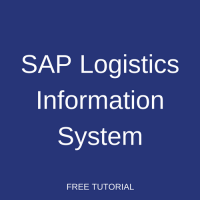 SAP Logistics Information System (LIS) is a set of flexible tools for collecting, aggregating and calculating data from the operative applications. In addition to this, the data can be used as the basis for planning. Hence, information systems can be used for controlling, monitoring and planning purposes. SAP Logistics Information System is part of the overall information system in the organization and corresponds to the logistics part of the SAP system.
SAP Logistics Information System (LIS) is a set of flexible tools for collecting, aggregating and calculating data from the operative applications. In addition to this, the data can be used as the basis for planning. Hence, information systems can be used for controlling, monitoring and planning purposes. SAP Logistics Information System is part of the overall information system in the organization and corresponds to the logistics part of the SAP system.
SAP Logistics Information System
Different information systems which make up Logistics Information System (LIS) can be seen on the picture below.

The subsets of Logistic Information System related to different SAP modules include the following:
SAP Sales and Distribution (SD) – In SAP SD module, all processes related to sales and distribution which includes placing orders by customers till the delivery of products are covered. It includes sales functions, packing, pricing, picking and shipping the product.
SAP Materials Management (MM) – In SAP MM module, all logistics functions of an organization are included like inventory movements, purchasing, material/vendor/service master data and invoice verification.
SAP Quality Management (QM) – In SAP QM Module, the overall quality of products is taken care of including planning and execution of purchases related to quality.
SAP Plant Maintenance (PM) – In SAP PM module, the focus is primarily on planning and execution of the preventive tasks on the equipment / machines / tools used in the process of production.
SAP Production Planning (PP) – In SAP PP module, the focus is on master production scheduling, capacity planning, material requirements planning needed for producing a company’s products.
Structure of SAP Logistics Information System
SAP Logistics Information System consists of the following levels:
- OLTP (Online Transaction Processing)
- Logistics Data Warehouse
- OLAP (Online Analytical Processing)

OLTP
OLTP (Online Transaction Processing) level consists of the different operative applications like Sales, Finance, Materials Management. This is the online transaction processing level. In this level, the system responds immediately to the user requests. The processing speed in OLTP is normally very fast. The data in concern is generally current data which is processed at this OLTP level. OLTP consists of the original source of data and used to run basic business tasks.
Logistics Data Warehouse
Logistics Data Warehouse lies above the OLTP level. Whenever a transaction is performed on the OLTP level in Sales, Finance or any other operative level, reduction in the data volume happens which is further reduced to statistically relevant parts. This data is supplied to and aggregated in the Logistics Data Warehouse.
OLAP
OLAP is also called as Online Analytical Processing. OLAP is used to process historical data. In this level, reporting tools for data evaluation are present. This is used for planning and problem solving. Some of the reporting tools include the following:
- Standard analysis
- Flexible analysis
- Early warning system
SAP Logistics Information System Customizing
The path to reach customizing for Logistics Information System is seen below:
SPRO -> IMG -> Logistics – General -> Logistics Information System (LIS)

SAP implementation guide offers built-in documentation about all steps of the customization. You can access the documentation by clicking on each icon with a sheet of paper and glasses next to the relevant customizing node.
—
Did you like this SAP MM tutorial? Have any questions or comments? We would love to hear your feedback in the comments section below. It’d be a big help for us, and hopefully it’s something we can address for you in improvement of our free SAP MM tutorials.
Navigation Links
Go to next lesson: SAP MM Info Structure
Go to previous lesson: SAP Vendor Invoice Report
Go to overview of the course: SAP MM Training

Hi, Please let me know the difference between the SAP-LIS and SAP-WM/SAP-WMS. Also want to know SAP-LIS efficiency level on cloud.
SAP LIS is part of SAP ERP and is used for reporting purposes. SAP WMS is a different application for Warehouse Management.